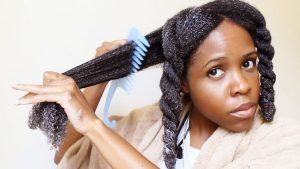How to Detangle Natural Hair to Avoid Breakage

Relaxed or natural hair needs to be carefully and patiently detangled before working with it. It helps a lot to remove as much shed hair as possible that may cause tangles, knots, or matting and breakage.
Detangling makes it very easy to work with the hair especially on washdays when your hair needs to be thoroughly cleansed and moisturized. For one to detangle, you need to be extremely gentle as possible in order not to cause harm and damage to your hair.
Here are some helpful tips on detangling your hair to avoid breakage.
What you need:
- Wide tooth comb
- Detangling brush
- Fingers
- Sectioning hair clips
- Spray bottle
- Detangler (conditioner/ oil/ aloe vera etc)
- Water
- Hair shear
How to Detangle:
1. Section your hair: you can easily detangle your hair in sections as this help to reduce tangles and it makes it much more easier to focus on one section without having to detangle your whole hair at once.
Start by dividing your hair in smaller sections using your fingers (maybe 4-6 sections depending on how long and thick your hair is). Twist/ braid/bantu knot/clip each section to secure the parts or divided portions of the hair.
2. Spritz hair and apply detangler: using your spray bottle, spritz your hair with warm water to get it damp. Using warm water helps to melt down product residues on your hair strands and slightly softens the hair. Using your hands and fingers, gently rake through the section to remove shed hair
3: Apply your detangler (conditioner, oil, aloe vera, etc): take a portion of your detangler and apply to the section of hair you’re working on. The detangler helps to provide enough lubrication and slip to the hair that makes detangling to be very easy. It also makes it easy to take through your hair with a comb or detangling brush. Make sure your detangler has a very great slip in order to make the detangling process to be easy.
4: Finger detangle: before using a comb or brush to glide through your hair, use your fingers to rake through the section of hai, gently separating the hair to remove more shed hair. The idea here is to remove as much shed hair as possible to reduce chances of hair matting and tangling up.
5: Comb and detangle: after making use of your fingers, go in with your wide tooth comb. You shouldn’t use any any type of comb especially fine tooth comb because it’ll make the job more difficult and frustrating. Comb your hair from the tips and proceed gently upward to the middle and roots. Don’t start combing from the roots or middle of your hair because the ends needs to be free from tangles before you can freely comb through. Once you feel your hair detangled, use your detangling brush to further remove any shed hair that stubbornly got stuck and hidden. At this point your hair should feel so smooth and well detangled.
6: use your hair shear: while detangling, instead of using your hands to rip off those shed hair that got stuck with your hair at the tip of your hair, use your hair shear to just cut or trim them off. Doing this will help reduce any form of split ends or damage that may lead to breakage.
7: Twist/braid/bantu knot your hair: after detangling each section, make sure to twist it or braid/ bantu knot each section as this helps to prevent your hair from tangling up again.
When to Detangle:
Detangle before and after shampoo on washdays.
you need to thoroughly detangle your hair before you proceed to shampoo because shampoo tends to make your hair clump together and when this happens, you’re rest assured that you don’t want to have shed hair that might ends up causing tangles in the hair and then add even more tangles by shampooing. After shampooing, you also need to seperate the hair that stick /clump together.You also want to re-separate the hair after shampooing. Rinse out shampoo and detangle again with your conditioner.
Detangle before styling your hair to make parting and styling your hair easy

